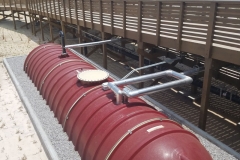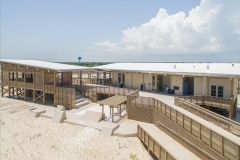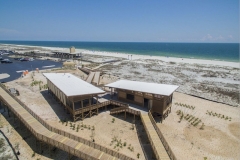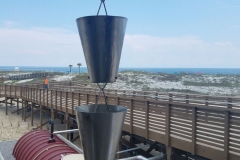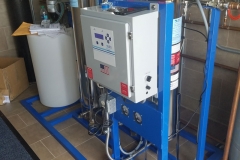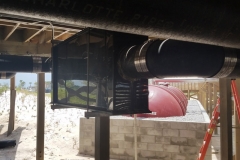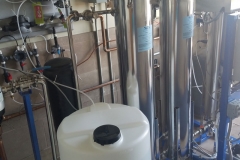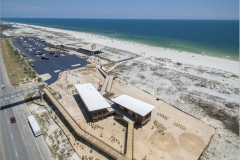Gulf State Park Interpretive Center Update: The system is now fully installed and operational, please view the video to see how this water management project has been put together on-site.
Video Update
The project is Living Building Challenge (LBC) certified, with the rainwater system fulfilling the “water petal” qualification. This means the project achieves true net-zero for water, with no outside water being used & with no stormwater runoff. All collected water meets the building needs including drinking water and non-potable uses. It is one of the first commercial-scale potable rainwater systems in the US.
Photo Gallery
Ecovie & Partners
Ecovie contracted with Bernhard MCC for the equipment to provide the commercial-scale potable rainwater system. Ecovie worked with Integral Group from conception through engineering design as well as working with Aqua Treatment Services (ATS) for the main water treatment. The system uses Intewa PURAIN pre-filtration and a Xerxes 11,000 gallon fiberglass cistern as the facility’s sole water supply. The water storage and treatment is such that no well or municipal back up supply is needed in addition to the water collected and treated on-site.
Although this is not the first commercial-scale potable rainwater system in the US. We know of only one in full operation and that is one at the Chesapeake Bay Foundation’s Brock Environmental Center in Virginia. It has been in operation since 2014 and has had great results.
The Gulf State Park System uses the same 3rd party EPA UVDGM validated treatment system from our development partner, ATS. A second system was recently installed in Virginia at the Chesapeake Public Safety Building and awaits commissioning. Ecovie has several other commercial potable rainwater systems in various stages of development. In addition to these commercial-scale potable rainwater systems, there are hundreds of single-family residential; scale systems in operation, many of which Ecovie has designed and installed.
About Rainwater
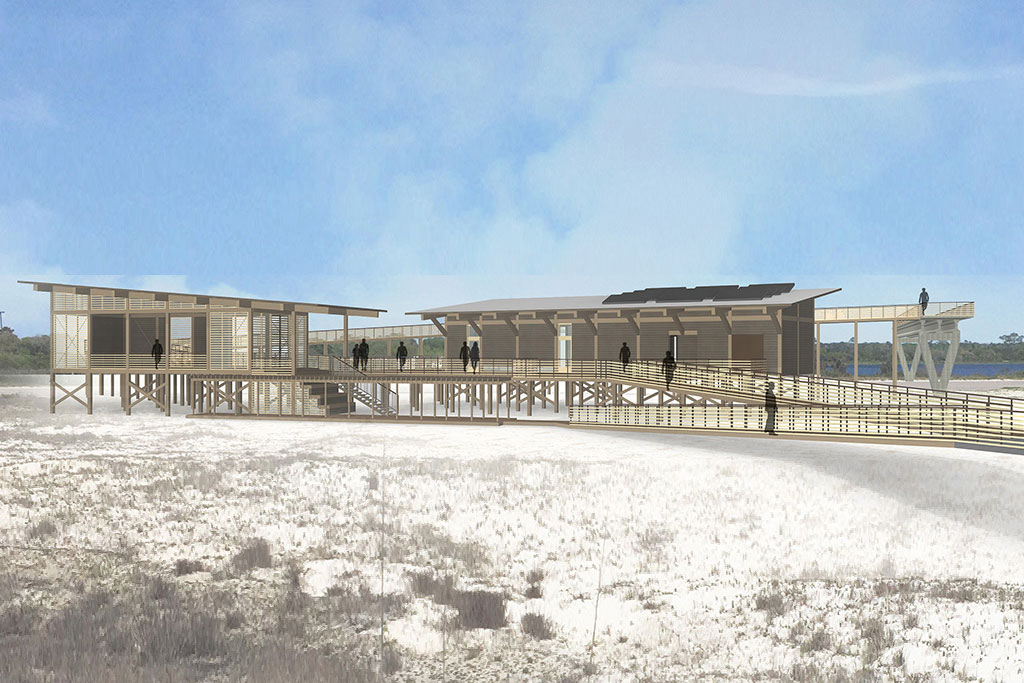
You may wonder how is it possible to use captured rainwater from a rooftop as a potable water source? I will get to that in a minute, but first, it is important to emphasize that roof captured rainwater is a primo water source. Typically this water contains a lot less contaminants than other typical water sources such as surface water and groundwater.
By not hitting the ground collected rainwater keeps away from contaminants that come from things like farm and industrial runoff, animal activity, and even discharge from our own water treatment plants. This means that treatment of roof captured rainwater need not be overly complicated or complex since it doesn’t contain the pathogens, pesticides, heavy metals, hydrocarbons, drugs, and other toxins found in other source waters.
On-Site Water System Design:
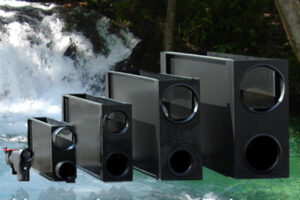
Like all Ecovie rainwater systems, the design starts with the basic fundamentals of rainwater collection and storage, following ARCSA/ASPE 63 guidelines. Our PURAIN jump filters efficiently pre-filters rain from the 6,300 square foot rooftop as it enters the cistern (NSF 61 certified).
From the tank, water is pumped on demand through treatment which is quite similar to residential scale potable systems with sediment and carbon filtration with UV. What differs is that for commercial scale we use a treatment which is fully 3rd party validated drinking water test proving actual bacteria, virus, and protozoa (cryptosporidium) elimination with at least a 4 log removal of pathogens (99.99% removal). The test results in fact showed over 7 log reduction (99.99999%), far exceeding the requirement. This is done using ATS multi-barrier treatment.
The ATS SKMB treatment is the only total disinfection treatment system tested with live organisms for MS2, Cryptosporidium, Bacillus Globigii, and Adenovirus with the EPA as well as having UVDGM 3rd party validation. This validation was done on each individual component and with the system as a whole. And perhaps more importantly, it is the only system already used successfully on a commercial scale potable rainwater system yielding clean, safe, great tasting water.
In order for the State of Alabama to permit the system, chlorine injection is required in addition our validated system to provide a low level residual disinfection downstream. While we are not crazy about putting a known carcinogen in our beautiful water, we completely understand the reasoning for adding a final level of protection for this first system in Alabama. Chlorine has been a standard water treatment method for over a century and most local standards still require its use.
The system uses monitoring equipment and uploads water quality data to a building management system (BMS). This helps with reporting requirements to the State. Parameters such as free chlorine, pH, and turbidity are monitored continuously as well as equipment status with the filtration, UV, and the pumping system.
We would be delighted to talk with anyone in detail about the Gulf State Park project and our approach to potable rainwater systems. Please feel free to get in contact.


